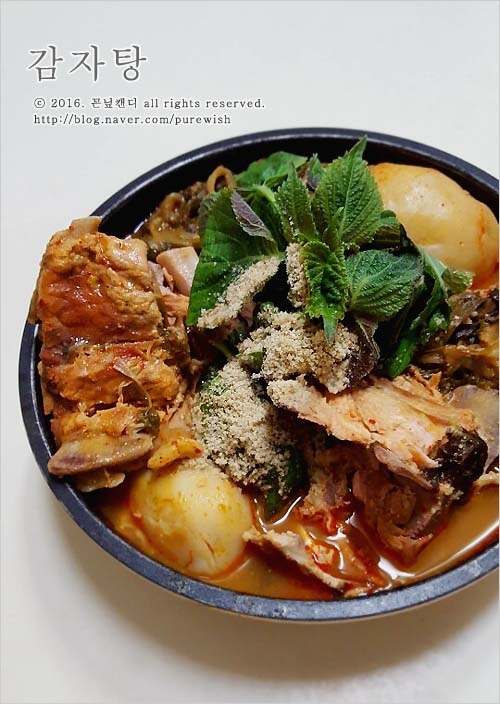
Pork Back-bone Stew.
These days, it's getting colder and colder, so I bought pork backbone right away because I thought of the thick-boiled pork back soup.
I immediately took out the blood and prepared to make it. And I took out the radish leaves that I had saved in advance and melted them.
It's okay if you don't have a saved radish and a cabbage.
There are soft and delicious sweet cabbages. :D
We often make gamjatang at home.
It's delicious even if you make it quickly, and I think it's thicker and tastier if you boil it the day before and eat it the next day.
The process seems to be long, but it's not that difficult, so make it full and have a warm meal with your family in the cold winter. :D
6 serving
Within 999 minutes

꼰닢캔디
- Ingredients
-
-
pork backbone3kg
-
Cabbage2pack
-
Potato5ea
-
Kkasun. (Korean word pun)2handful
-
perilla powder8~10TS
-
dried radish greens2pack
-
Ginger2piece
-
Whole pepper1TS
-
Cheongju1cup
-
cooking wine1/2cup
-
Soybean paste8TS
-
Red pepper powder7TS
-
Korean style soy sauce3TS
-
cooking wine3TS
-
crushed garlic3TS
-
Sesame oil1TS
-
ground pepper1/2TS
-
- Cooking Steps
-
STEP 1/91. Drain the blood from the pork backbone for half a day.
- Pour the water so that the backbone of the pig is fully submerged, and drain the blood by changing it to clean water in between.
(I didn't have much blood that day. On this day, I drained the blood for about 3 hours and started cooking.) STEP 2/92. Mix together the amount of seasoning ingredients.
STEP 2/92. Mix together the amount of seasoning ingredients.
- It's good to mix the sauce in advance while removing the blood from the pork backbone.
The dry ingredients (red pepper powder) are moist and blend well to taste good. STEP 3/93. Cut the bottom of the cabbage and wash it in clean water.
STEP 3/93. Cut the bottom of the cabbage and wash it in clean water.
(You have to pay attention to the stem from which the bottom is cut off. There could be dirt hiding.)
4. Add a little salt to boiling water, blanch the sweet cabbage slightly, soak it in cold water straight away, cool it down, and strain it through a sieve.
TIP. If you boil it for a long time, it can be soft and crumbly. Take a piece of cabbage and shake it in cold water to cool it down and fold the stem
As long as it doesn't break and bends gently, remove it from the boiling water.
5. Peel the potatoes, boil them for 15 minutes, scoop them out, and prepare them.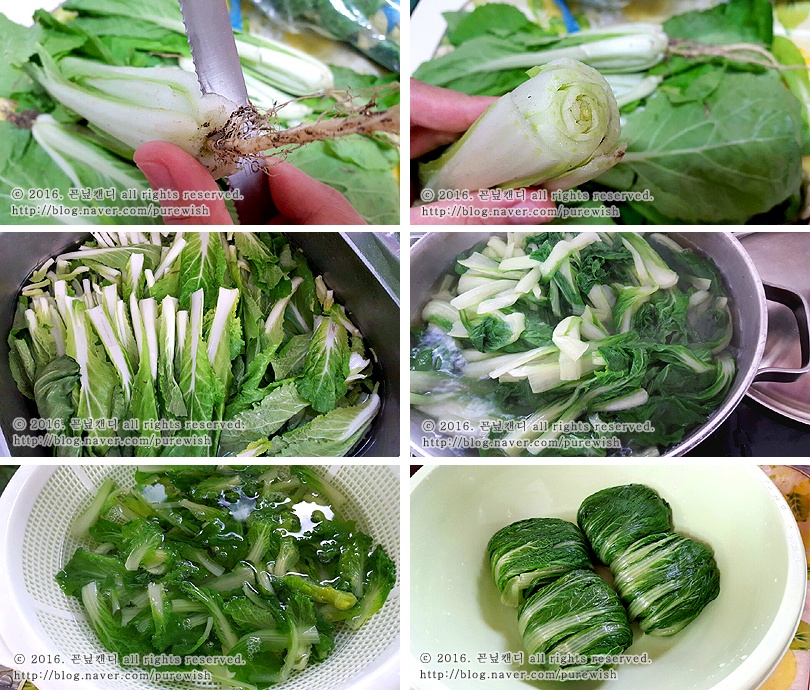 STEP 4/9(After the blood is drained. The color of the meat is lighter and the water is clear before the blood is drained.)
STEP 4/9(After the blood is drained. The color of the meat is lighter and the water is clear before the blood is drained.)
6. Fill the pot with enough water, and when the water boils, add the prepared backbone and blanch it slightly to remove it.
- It is not a completely cooked process, but a process to remove impurities such as remaining blood and bone powder. STEP 5/97. Then rinse slightly under running water to prepare.
STEP 5/97. Then rinse slightly under running water to prepare.
- It is the process of rinsing out the solidified blood that can stick to the bone cross section or while cooking.
If I wipe it too hard, the delicious parts will be washed away, right? You can rinse it a little bit. STEP 6/98. Put the trimmed backbone in a clean pot again, add 3.5L of water, sliced ginger, whole pepper, cheongju, and cooking wine, and bring to a boil over high heat.
STEP 6/98. Put the trimmed backbone in a clean pot again, add 3.5L of water, sliced ginger, whole pepper, cheongju, and cooking wine, and bring to a boil over high heat.
Bring to a simmer, let simmer for about 10 minutes, then remove the dull foam that floats upward.
Watch and gently scoop out the rising impurities for about 5 minutes. (The broth cleared up after taking it out.)
When removed, cover slightly obliquely and simmer for 30 minutes over medium-low heat. STEP 7/99. In the meantime, add 10 tablespoons of sauce to the blanched cabbage and mix them well.
STEP 7/99. In the meantime, add 10 tablespoons of sauce to the blanched cabbage and mix them well.
(Season in advance. I added extra radish because I had saved it in advance.)
In 30 minutes...
10. Remove the fat from the top, add 1L of water and simmer for another 1 hour and 30 minutes over a gentle heat. STEP 8/911. Remove the backbone separately and strain the broth cleanly through a sieve.
STEP 8/911. Remove the backbone separately and strain the broth cleanly through a sieve.
- It is the process of filtering out the soft bones that fell off while brewing ginger, whole pepper, and broth.
12. Put the stock and backbone in the pot again and boil it for about 20 minutes with seasoned sweet cabbage, then boil the boiled potatoes for another 10 minutes. STEP 9/913. Lastly, add sesame seeds and perilla powder and finish!
STEP 9/913. Lastly, add sesame seeds and perilla powder and finish!
- You can add more perilla powder to suit your taste.
I made enough marinade (used for seasoned sweet cabbage). You can season it with this.
If you still think you need more salt, you can add more salt. - Cabbage can be soft and lumpy if boiled for a long time. Take a piece of cabbage and shake it gently in cold water to cool it off If you fold it and it doesn't break and just bends smoothly Remove from boiling water. - It may be annoying, but it's good to make broth, take out the backbone, and strain the broth through a sieve. It's a process to filter out tiny pieces of bone that have fallen off.
- Cabbage can be soft and lumpy if boiled for a long time. Take a piece of cabbage and shake it gently in cold water to cool it off If you fold it and it doesn't break and just bends smoothly Remove from boiling water. - It may be annoying, but it's good to make broth, take out the backbone, and strain the broth through a sieve. It's a process to filter out tiny pieces of bone that have fallen off.
- Cooking review
-
4.00score
-
 543*****scoreI made it deliciously and ate it well.2016-11-14 23:00
543*****scoreI made it deliciously and ate it well.2016-11-14 23:00
-
- Bulgogi Recommended recipe
-
-
1
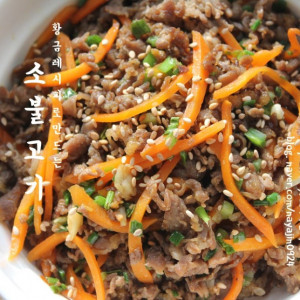 How to make beef bulgogi golden recipe without failure4.97(89)
How to make beef bulgogi golden recipe without failure4.97(89) -
2
 Spicy and sweet red pepper paste pork bulgogi4.97(39)
Spicy and sweet red pepper paste pork bulgogi4.97(39) -
3
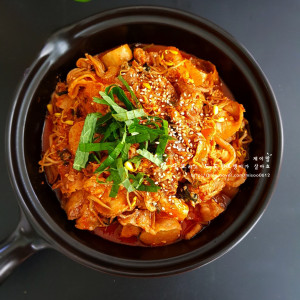 Jongwon Baek Pork Belly Pork Belly Bean Sprout Bulgogi4.96(477)
Jongwon Baek Pork Belly Pork Belly Bean Sprout Bulgogi4.96(477) -
4
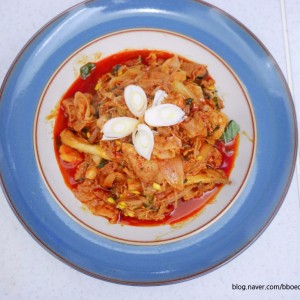 Jongwon Baek Bean sprout bulgogi golden recipe rice thief~4.89(63)
Jongwon Baek Bean sprout bulgogi golden recipe rice thief~4.89(63)
-
- Japchae Recommended recipe
-
-
1
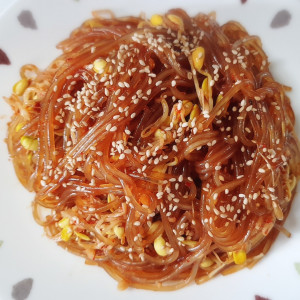 Have you tried bean sprout japchae?4.83(30)
Have you tried bean sprout japchae?4.83(30) -
2
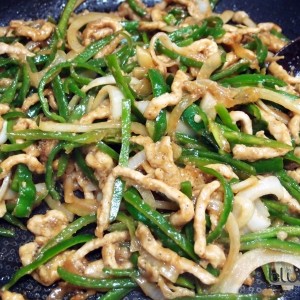 Chef Lee Yeonbok makes chili japchae4.88(16)
Chef Lee Yeonbok makes chili japchae4.88(16) -
3
 Japchae4.88(16)
Japchae4.88(16) -
4
 Many reviews acknowledged the recipe for japchae~ How to make ja4.79(14)
Many reviews acknowledged the recipe for japchae~ How to make ja4.79(14)
-